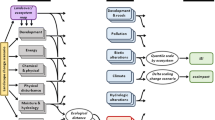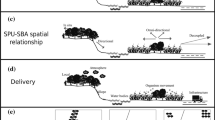Abstract
Increasingly, natural resources agencies and organizations are using measures of ecological integrity to monitor and evaluate the status and condition of their landscapes, and numerous methods have been developed to map the pattern of human activities. In this paper I apply formal methods from decision theory to develop a transparent ecological indicator of landscape integrity. I developed a parsimonious set of stressors using an existing framework to minimize redundancy and overlap, mapping each variable as an individual data layer with values from 0 to 1.0, and then combined them using an “increasive” function called fuzzy sum. A novel detailed land use dataset is used to generate empirical measures of the degree of human modification to map important stressors such as land use, land cover, and presence, use, and distance from roads. I applied this general framework to the US and found that the overall average degree of human modification was 0.375. Regional variation was fairly predictable, but aggregation of these raw values into terrestrial or watershed units resulted in large differences at local to regional scales. I discuss three uses of these data by land managers to manage protected areas within a dynamic landscape context. This approach generates an internally-valid model that has a direct, empirical, and physical basis to estimate the degree of human modification.






Similar content being viewed by others
References
Angermeier PL, Karr JS (1994) Biological integrity versus biological diversity as policy directives. BioScience 44(10):690–697
Aplet G, Thomson J, Wilbert M (2000) Indicators of wildness: using attributes of the land to assess the context of wilderness. In: McCool SF, Cole DN, Borrie WT, O’Loughlin J (eds) Wilderness science in a time of change conference. Proceedings RMRS-P-15-VOL-2, Ogden, UT. U.S. Department of Agriculture, Forest Service, Rocky Mountain Research Station, pp 89–98
Baldwin RF, Reed SE, McRae BH, Theobald DM, Sutherland RW (2012) Connectivity restoration in large landscapes: modeling landscape condition and ecological flows. Ecol Restor 30:274–279
Bierwagen B, Theobald DM, Pyke CR, Choate CA, Groth P, Thomas JV, Morefield P (2010) National housing and impervious surface scenarios for integrated climate impact assessments. Proc Nat Acad Sci USA 107(49):20887–20892
Bonham-Carter GF (1994) Geographic information systems for geoscientists: modeling with GIS. Pergamon, Oxford
Borja A, Bricker SB, Dauer DM, Demetriades NT, Ferreira JG, Forbes AT, Hutcings P, Jia X, Kenchington R, Marques JC, Zhu C (2008) Overview of integrative tools and methods in assessing ecological integrity in estuarine and coastal systems worldwide. Mar Pollut Bull 56:1519–1537
Bradley BA, Marvin DC (2011) Using expert knowledge to satisfy data needs: mapping invasive plant distributions in the western US. West North Am Nat 71(3):302–315
Brown MT, Vivas MB (2005) Landscape development intensity index. Environ Monit Assess 101:289–309
Carroll C, McRae B, Brookes A (2012) Use of linkage mapping and centrality analysis across habitat gradients to conserve connectivity of gray wolf populations in western North America. Conserv Biol 26:78–87
Coffin AW (2007) From roadkill to road ecology: a review of the ecological effects of roads. J Transp Geogr 15(5):396–406
Copeland HE, Doherty KE, Naugle DE, Pocewicz A, Kiesecker JM (2009) Mapping oil and gas development potential in the US intermountain west and estimating impacts to species. PLoS ONE 4(1):e7400
Esselman PC, Infante DM, Wang L, Wu D, Cooper AR, Taylor WW (2011) An index of cumulative disturbance to river fish habitats of the conterminous United States from landscape anthropogenic activities. Ecol Restor 29(1–2):133–151
Fahrig L, Rytwinski T (2009) Effects of roads on animal abundance: an empirical review and synthesis. Ecol Soc 14(1): 21. http//www.ecologyandsociety.org/vol14/iss1/art21/. Accessed 16 Sep 2013
Falcone JA, Carlisle DM, Weber LC (2010) Quantifying human disturbance in watersheds: variable selection and performance of a GIS-based disturbance index for predicting the biological condition of perennial streams. Ecol Indic 10:264–273
Fancy SG, Gross JE, Carter SL (2008) Monitoring the condition of natural resources in US National Parks. Environ Monit Assess 151:161–174
Federal Communications Commission (FCC) (2012) Antenna structure registration. http://wireless.fcc.gov/antenna/index.htm?job=home. Accessed 16 Sep 2013
Federal Highway Administration (FHA) (2010) National Transportation Atlas Database 2010. DVD published by the Research and Innovative Technology Administration, Bureau of Transportation Statistics
Forman RTT, Sperling D, Bissonette JA, Clevenger AP, Cutshall CD, Dale VH, Fahrig L, France R, Goldman CR, Heanue K, Jones JA, Swanson FJ, Turrentine T, Winter TC (2003) Road ecology: science and solutions. Island, Washington, DC
Fry JA, Xian G, Jin S, Dewitz JA, Homer CG, Yang L, Barnes CA, Herold ND, Wickham JD (2011) Completion of the 2006 national land cover database for the conterminous United States. Photogramm Eng Remote Sens 77:858–864
Gardner RH, Urban DL (2007) Neutral models for testing landscape hypotheses. Landscape Ecol 22:15–29
Gardner RH, Milne BT, Turner MG, O’Neill RV (1987) Neutral models for the analysis of broad-scale landscape pattern. Landscape Ecol 1:19–28
Gelbard JL, Belnap J (2003) Roads as conduits for exotic plants in a semi-arid landscape. Conserv Biol 17:420–432
Grossman DH, Faber-Langendoen D, Weakley AS, Anderson M, Bourgeron P, Crawford R, Goodin K, Landaal S, Metzler K, Patterson KD, Pyne M, Reid M, Sneddon L (1998) International classification of ecological communities: terrestrial vegetation of the United States. The national vegetation classification system: development, status, and applications, vol 1. The Nature Conservancy, Arlington
Hajkowicz S, Collins K (2007) A review of multi-criteria analysis for water resource planning and management. Water Resour Manag 21(9):1553–1566
Hannah L, Carr JL, Lankerani A (1995) Human disturbance and natural habitat: a biome level analysis of a global data set. Biodivers Conserv 4:128–155
Hansen AJ, Davis CR, Piekielek N, Gross J, Theobald DM, Goetz S, Melton F, DeFries R (2011) Delineating the ecosystems containing protected areas for monitoring and management. BioScience 61:363–373
IUCN (2006) Evaluating effectiveness: a framework for assessing management of protected areas, 2nd edn., Best practice protected area guidelines series No. 14IUCN, Gland and Cambridge
Leibowitz S, Cushman S, Hyman J (1999) Use of scale invariance in evaluating judgment indicators. Environ Monit Assess 58:283–303
Leinwand IIF, Theobald DM, Mitchell J, Knight RL (2010) Land-use dynamics at the public–private interface: a case study in Colorado. Landsc Urban Plan 97(3):182–193
Leu M, Hanser SE, Knick ST (2008) The human footprint in the West: a large-scale analysis of anthropogenic impacts. Ecol Appl 18(5):1119–1139
Lindenmayer DB, Margules CR, Botkin DB (2000) Indicators of biodiversity for ecologically sustainable forest management. Conserv Biol 14(4):941–950
McRae BH, Hall SA, Beier P, Theobald DM (2012) Where to restore ecological connectivity? Detecting barriers and quantifying restoration benefits. PLoS ONE 7(12):e52605
Neel MC, McGarigal K, Cushman SA (2004) Behavior of class-level landscape metrics across gradients of class aggregation and area. Landscape Ecol 19:435–455
Noon B (2003) Conceptual issues in monitoring ecological resources. In: Busch D, Trexler J (eds) Monitoring ecosystems: interdisciplinary approaches for evaluating ecoregional initiatives. Island Press, Washington, DC, pp 27–72
Noss RF (1990) Indicators for monitoring biodiversity: a hierarchical approach. Conserv Biol 4(4):355–364
Parrish JD, Braun DP, Unnasch RS (2003) Are we conserving what we say we are? Measuring ecological integrity within protected areas. BioScience 53(9):851–860
Poff NL, Hart DD (2002) How dams vary and why it matters for the emerging science of dam removal. BioScience 52(8):659–668
Riitters KH, Wickham JD, Wade TG (2009) An indicator of forest dynamics using a shifting landscape mosaic. Ecol Indic 9(1):107–117
Salafsky N, Salzer D, Stattersfield AJ, Hilton-Taylor C, Neugarten R, Butchart SHM, Collen B, Cox N, Master LL, O’Connor S, Wilkie D (2008) A standard lexicon for biodiversity conservation: unified classifications of threats and actions. Conserv Biol 22(4):897–911
Sanderson EW, Jaiteh M, Levy MA, Redford KH (2002) The human footprint and the last of the wild. BioScience 52(10):891–904
Schultz MT (2001) A critique of EPA’s index of watershed indicators. J Environ Manag 62:429–442
Theobald DM (2005) Landscape patterns of exurban growth in the USA from 1980 to 2020. Ecol Soc 10(1):32. Available from: http://www.ecologyandsociety.org/vol10/iss1/art32/. Accessed 16 Sep 2013
Theobald DM (2010) Estimating changes in natural landscapes from 1992 to 2030 for the conterminous United States. Landscape Ecol 25(7):999–1011
Theobald DM (2013) Integrating land use and landscape change with conservation planning. In: Craighead L, Convis C (eds) Shaping the future: conservation planning from the bottom up. Esri, Redlands, pp 105–121
Theobald DM, Reed SE, Fields K, Soule M (2012) Connecting natural landscapes using a landscape permeability model to prioritize conservation activities in the US. Conserv Lett 5(2):123–133
US Geological Survey (2011) Mineral resources data system. http://tin.er.usgs.gov/mrds/. Accessed 16 Sep 2013
US Geological Survey Gap Analysis Program (2011) National land cover, version 2. http://gapanalysis.usgs.gov/gaplandcover/. Accessed 16 Sep 2013
Wade AA, Theobald DM, Laituri M (2011) A multi-scale assessment of local and contextual threats to existing and potential US protected areas. Landsc Urban Plan 101:215–227
Wickham JD, Riitters KH, Wade TG, Homer C (2008) Temporal change in fragmentation of continental US forests. Landscape Ecol 23:891–898
Wiens JA (1989) Spatial scaling in ecology. Funct Ecol 3:385–397
Wiens JA (2002) Riverine landscapes: taking landscape ecology into the water. Freshw Biol 47:501–515
Woolmer G, Trombulak SC, Ray JC, Doran PJ, Anderson MG, Baldwin RF, Morgan A, Sanderson EW (2008) Rescaling the human footprint: a tool for conservation planning at an ecoregional scale. Landsc Urban Plan 87:42–53
Acknowledgments
Thanks to the Western Governor’s Association Landscape Integrity working group members for discussions that helped to shape this work, particularly J. Pierce, R. Baldwin, P. Comer, B. Dickson, K. McKelvey, B. McRae, and S. Reed. I also appreciate comments by two peer-reviewers, earlier reviews by W. Monahan and L. Zachmann, and the interpretation and data collection efforts by I. Leinwand, D. Mueller, P. Holsinger, T. Andres, and L. Halvorson. This work was supported by a NASA Decision Support award through the Earth Science Research Results Program.
Author information
Authors and Affiliations
Corresponding author
Rights and permissions
About this article
Cite this article
Theobald, D.M. A general model to quantify ecological integrity for landscape assessments and US application. Landscape Ecol 28, 1859–1874 (2013). https://doi.org/10.1007/s10980-013-9941-6
Received:
Accepted:
Published:
Issue Date:
DOI: https://doi.org/10.1007/s10980-013-9941-6




